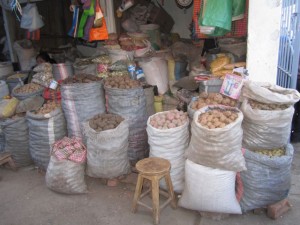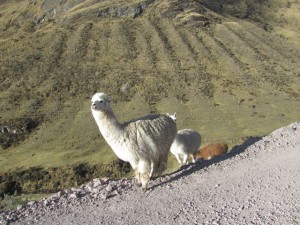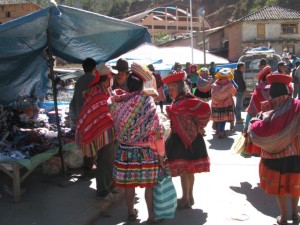Shaman Boot Camp
As you may have gathered by now, I had absolutely no idea what I was getting myself into when I jumped on that plane to Peru…and it just got worse.
Our first day was billed as a field trip—a journey to sacred hot springs high in the Andes. Our bodies needed to be cleansed before we could begin. We stopped at a small market and Francoise and I each bought two bags of coca leaves: one for altitude sickness, the other for readings when Doris would check our progress as well as give us tidbits about our future.
Back in the van we soon turned onto a narrow, dirt road that hugged the edge of a jagged mountain. There was no guardrail on the pot-holed path, only a view of hairpin turns and a desolate valley below—WAY below. In the distance, herds of llama munched on yellow grass and stone huts dotted the barren landscape.
When the driver took yet another curve at full speed, I reluctantly asked him to slow down. He ignored my plea as I clutched my stomach, trying to push back the nausea and fear. José instructed me to chew on more coca, like a peasant woman until dark green juice dripped from the corners of my mouth.
We were crossing the mountains at 10,000 feet before lowering into a valley and our finally destination of Laras where we spent the day submerged in murky warm water that reeked of sulfur. The springs consisted of different pools with varying temperatures and bathing suit clad brown bodies surrounded us. Women’s decorative skirts and bowler hats laid nearby in the grass. Lunch was fished from the mountain stream: trout with assorted local potatoes—blue, purple and brown. I savored every bite.
Then, the sun quickly dropped and we returned to our down coats, wool scarves and hats. The moment I had been dreading arrived. Within minutes I wanted to be hurled down the mountain and get the inevitable over with. The endless curves and stress of waiting for the exact moment of my demise bought on a case of severe gastritis that lasted for weeks. I did have an alternate plan though—to walk home. Yes, I could walk, 30-40 miles in the looming darkness, only to be found in the morning clutching the underbelly of a llama—if I were lucky. On second thought, I stayed in the van.
I dreamt of arriving to a hot shower…I was at a “spa” after all, but instead I returned to a large black cauldron of boiling water in the back yard. It was full of plants and flowers and had a lovely aroma. I was told to bathe beside the cauldron. Doris handed me a carved-out wooden gourd and said to use the plants for scrubbing. Modesty, as well as the fear of the frozen air, made me decline until the scented brew wooed me to disrobe. Looking at snow-covered peaks I took the first of my daily outdoor bathes, learning to enjoy them…but not as much when the next-door neighbor plowed his field. He tried not to look in my direction, his tethered bull huffing and puffing on the other side of the rickety wooden fence.
The next day, cleansed and (somewhat) purified I began my new regiment:
-A 6, sometimes 7am, wake-up call for an ice bath—this consisted of sitting on a wooden plank over a large tub filled with ice water and scooping the liquid onto my abdomen still swollen from the surgery for an hour…one hour, timed to the minute, dressed only in wool socks and warm boots with a coat for my back side.
-A vegetarian diet with no caffeine or alcohol—a task I didn’t think possible, but it was the easiest part, mostly due to the excellent food: exotic fruits, tasty varieties of potatoes, pilta: smashed avocados with loads of garlic and wonderful salads and vegetable casseroles.
-Breathing and meditation exercises, as well as the promised mud, or rather clay baths: cold clay slathered on my abdomen, then waiting, fighting back shivers, as it dried and peeled away, my skin underneath a hot red where the heat of inflammation released itself. I learned that this is an ancient method of healing, practiced by most indigenous societies.
-Massage, but not really. It was the moving of blocked energy, prodded along with strong, poky fingers. Doris believes our traumas and sorrows are bundled inside our bodies, blocking our natural flow, and to truly achieve health and happiness they must be removed.
And that’s when she informed me that the following day the washuma ceremony would take place…the reason I had come to Peru. I told her I didn’t know what she was talking about, I had never heard of washuma. Didn’t she understand I was there to study healing with plants. “And your first patient is yourself,” she replied.
I quickly learned that washuma isn’t a plant, or at least by my definition, but a cactus also known by the name of San Pedro. It’s known as an ancient healer, loaded in mescaline and other psychoactive compounds. People in the Andes have used it for medicine for thousands of years.
“You’re mistaken, I didn’t come here for that,” I informed Doris. “I don’t do that sort of thing.” She gave me an all-knowing smile and nodded ok.
…to be continued
Tags: delicious expeditions, healing with mud, kris rudolph, Laras, Peru, Sacred Valley, washuma






